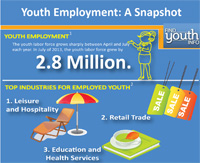Youth who receive special education services under the Individuals with Disabilities Education Act (IDEA 2004) and especially young adults of transition age, should be involved in planning for life after high school as early as possible and no later than age 16. Transition services should stem from the individual youth’s needs and strengths, ensuring that planning takes into account his or her interests, preferences, and desires for the future.
Employment Experiences for Youth

Click to Enlarge The current economic climate has made securing and sustaining a job difficult for all Americans, including youth. Certain populations of youth—including those who are or have been involved in the foster care system or the juvenile justice system, runaway or homeless youth, youth who have dropped out of high school, pregnant or parenting youth, and youth with disabilities—have additional challenges in getting early work experience. These youth often face increased barriers to employment, such as lack of documentation, transportation, child care, or support. They may have a transient lifestyle or have to overcome stigma, mental illness, substance abuse, previous felonies, or a juvenile record. Despite the challenges, most young people have held a job by the time they are 25,1 with many seeking employment during summer months. In 2013, more than half (50.7 percent2) of young people between the ages of 16 and 24 were employed between April and July, an increase of 2.1 million youth for the same period in 2012.3
Data Sources
To find the most recent data on youth employment and unemployment, visit the data sources below.
National Longitudinal Surveys
The National Longitudinal Surveys, including the National Longitudinal Survey of Youth (NLSY), are designed to gather information at multiple points in time on labor market activities and other significant life events of several groups of men and women.
U.S. Bureau of Labor Statistics
The U.S. Bureau of Labor Statistics (BLS) is the principal fact-finding agency for the federal government in the broad field of labor economics and statistics. Data can be found on youth employment, unemployment, employment by education level, employment by race and gender, and employment for young people with disabilities. See the range of data reports available at http://www.bls.gov/opub/ted/youth.htm.
References
Other Resources on this Topic
Agencies
Announcements
Collaboration Profiles
Data Sources
Feature Articles
Internships
Job Opportunities
Programs
Publications
Resources
Technical Assistance
Tools & Guides
Training Resources
Videos & Podcasts
Websites
Youth Topics
Youth Briefs
Research links early leadership with increased self-efficacy and suggests that leadership can help youth to develop decision making and interpersonal skills that support successes in the workforce and adulthood. In addition, young leaders tend to be more involved in their communities, and have lower dropout rates than their peers. Youth leaders also show considerable benefits for their communities, providing valuable insight into the needs and interests of young people
Statistics reflecting the number of youth suffering from mental health, substance abuse, and co-occurring disorders highlight the necessity for schools, families, support staff, and communities to work together to develop targeted, coordinated, and comprehensive transition plans for young people with a history of mental health needs and/or substance abuse.
Nearly 30,000 youth aged out of foster care in Fiscal Year 2009, which represents nine percent of the young people involved in the foster care system that year. This transition can be challenging for youth, especially youth who have grown up in the child welfare system.
Research has demonstrated that as many as one in five children/youth have a diagnosable mental health disorder. Read about how coordination between public service agencies can improve treatment for these youth.
Civic engagement has the potential to empower young adults, increase their self-determination, and give them the skills and self-confidence they need to enter the workforce. Read about one youth’s experience in AmeriCorps National Civilian Community Corps (NCCC).






